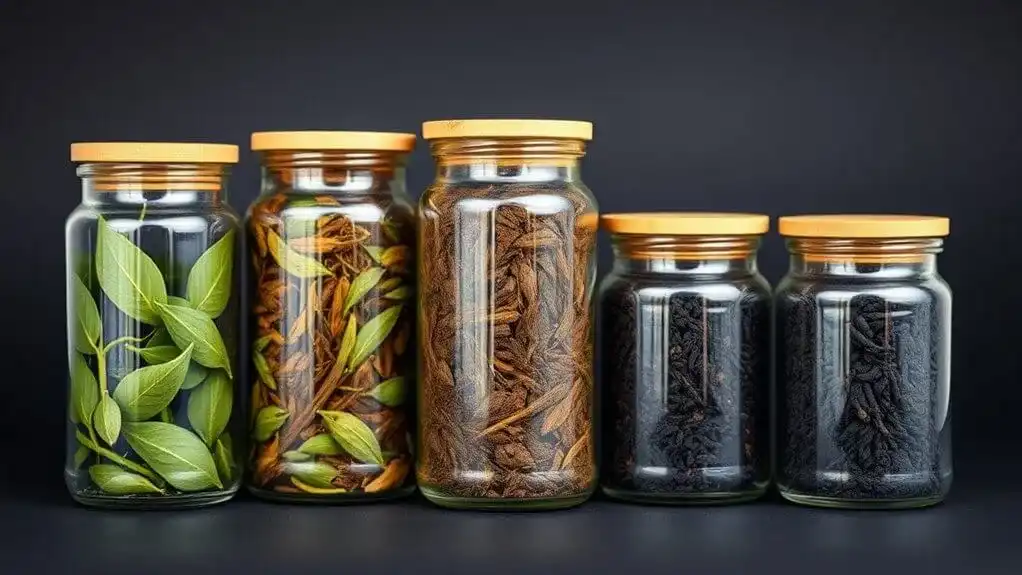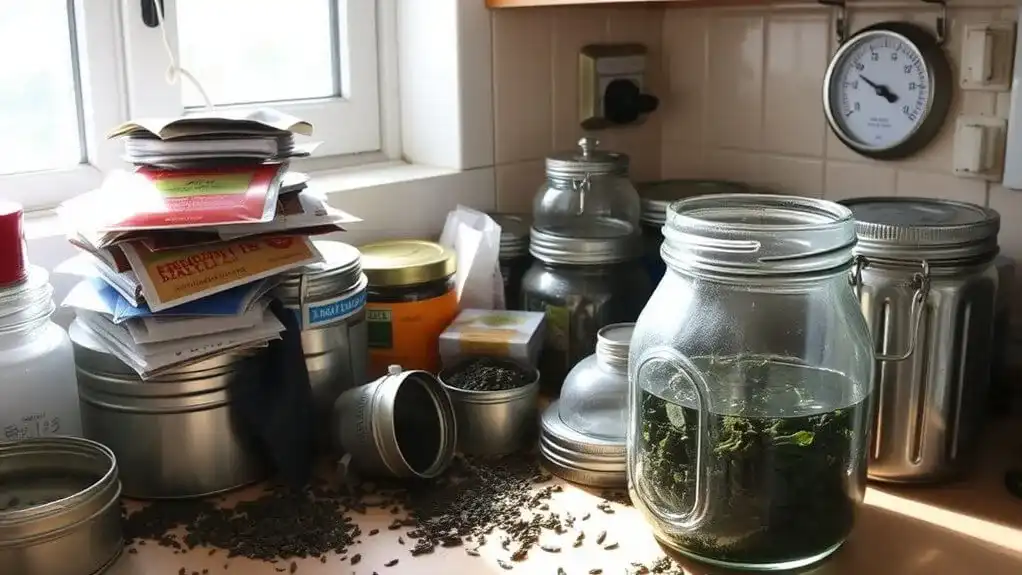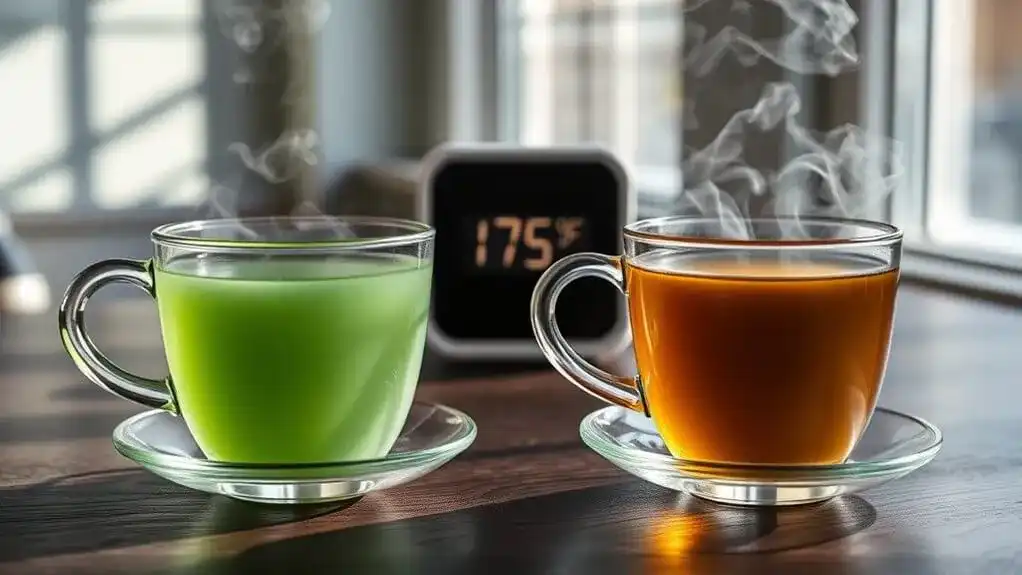Reading tea labels doesn't have to be confusing. Essential elements include the product name, net weight, ingredients list, and certification logos in the bottom third of the label. Smart shoppers check for allergen declarations, country of origin, and brewing instructions. Health claims require FDA approval, while symbols like USDA Organic and Fairtrade verify production standards. There's a whole world of tea knowledge waiting to be discovered on every carefully crafted label.
Key Points
- Look for essential details in the Principal Display Panel: tea name, brand, net weight, and any certification logos.
- Check the ingredient list thoroughly for allergens, additives, and whether it's a pure tea or blend.
- Verify brewing instructions match tea type: boiling water for black tea, lower temperatures for green/white teas.
- Examine storage guidelines and ensure packaging protects tea from light, heat, moisture, and strong odors.
- Review health claims skeptically and look for official certifications like USDA Organic or Fairtrade labels.
Essential Information Every Tea Label Must Have
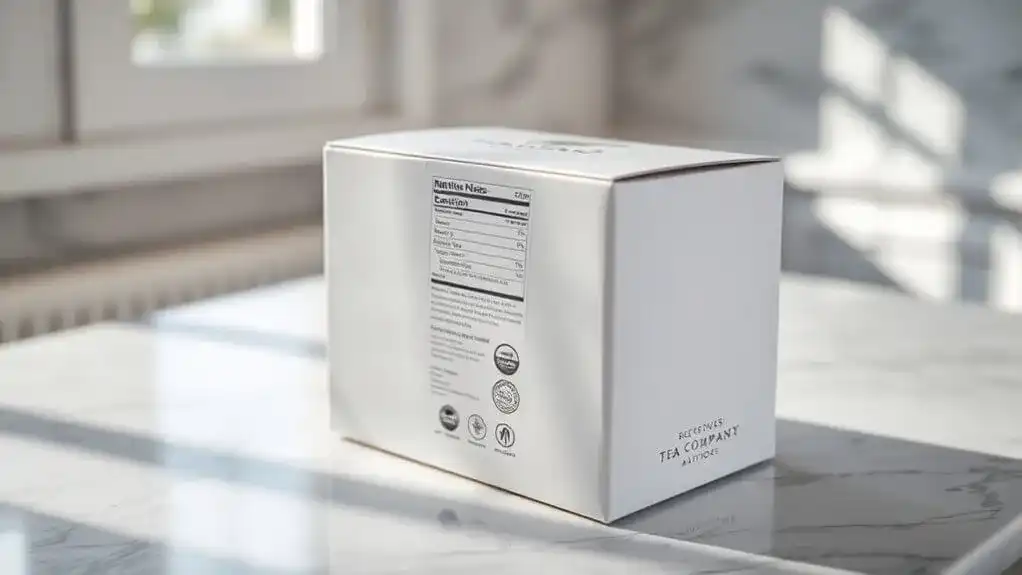
Four essential categories of information must appear on every tea label to meet regulatory requirements and inform consumers effectively. The first category, product identification, includes the tea's name, brand identity, net weight, and any relevant certification logos. For dietary supplements, this designation must be clearly stated. All herbal tea ingredients and allergen declarations require thorough detailed lists as mandated by regulations. Consumers should note that jasmine tea drinks can contain high sugar content, with most varieties containing between 48-67 grams of sugar per serving. The Principal Display Panel must show net contents in parallel base type to ensure clear visibility for consumers.
Manufacturing details form another vital category, requiring the country of origin and thorough manufacturer information. The label must display the company's name and full address, unless it's listed in a current directory. When applicable, distributor information needs proper identification with qualifying phrases.
Tea labels also require special labeling elements like botanical names for herbal varieties and flavor specifications. Finally, the design must incorporate all required information while maintaining legibility and proper placement of elements like barcodes and disclaimers.
Decoding the Ingredient List and Allergens
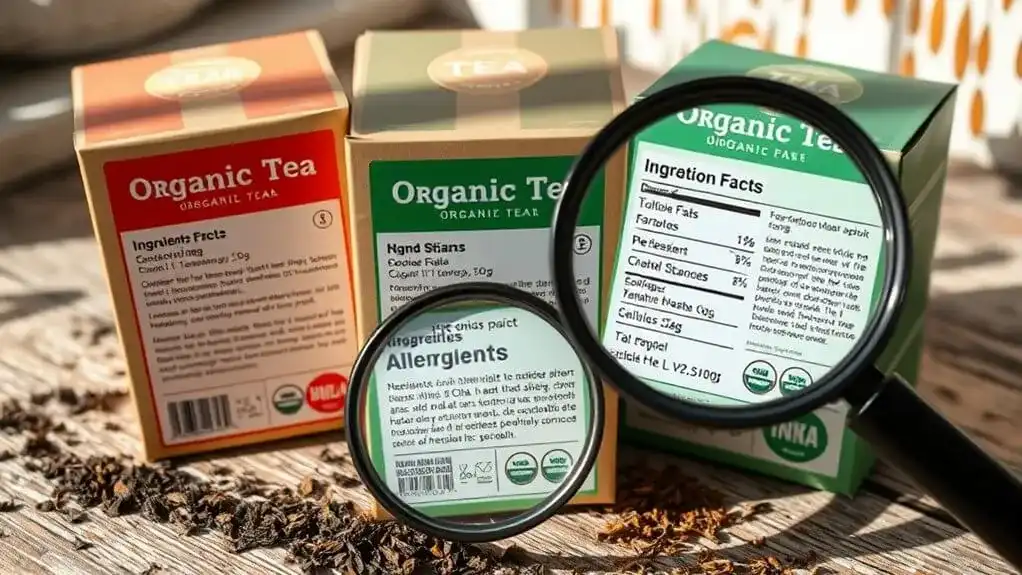
Understanding a tea product's ingredient list requires careful attention to both common additives and potential allergens. Modern tea products often contain preservatives like potassium sorbate and sodium benzoate, while ingredient transparency reveals the presence of additives such as high fructose corn syrup and phosphoric acid. Tea extracts and flavorings may include brewed tea extracts, green tea extract, and tea aromas enhanced with various acids. Many restaurants rely on tea concentrate methods instead of fresh brewing for their iced tea service. Camellia sinensis plant produces the four main types of traditional tea: black, green, oolong, and white tea.
Allergen awareness is essential as some individuals may experience reactions to compounds like epigallocatechin gallate. Those with birch, grass, or mugwort pollen allergies should be particularly cautious. While rare, allergic reactions can include throat swelling, breathing difficulties, and nasal congestion. Labels must clearly indicate the tea type, origin, and whether it's a blend, helping consumers make informed choices about their tea selections.
Understanding Weight, Dates, and Origins
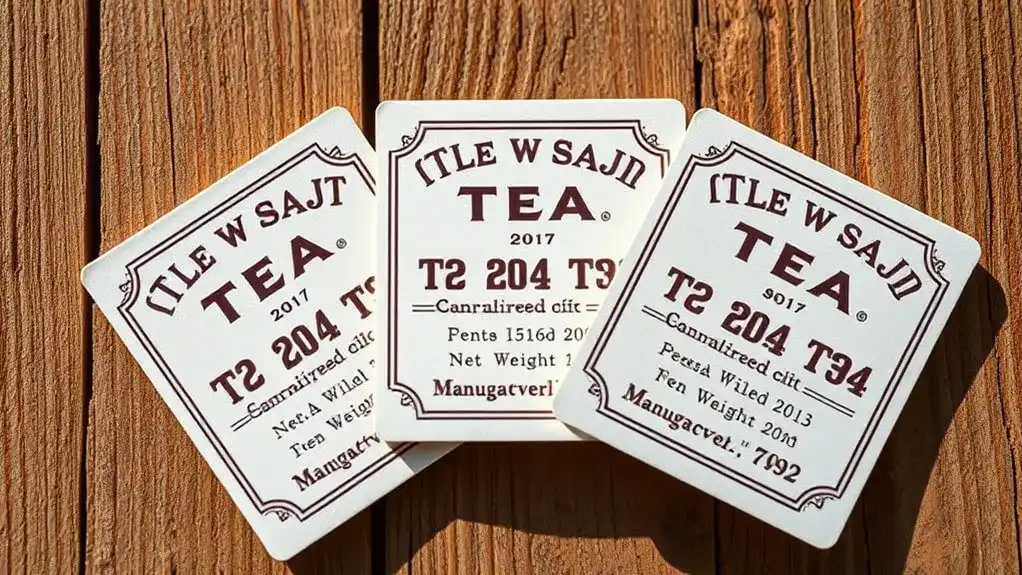
When reading tea labels, three critical elements deserve special attention: weight measurements, date information, and origin details.
The net weight must appear clearly on the label, often showing both ounces and grams. For tea bags, it's common to see both the count and weight listed, such as "10 TEA BAGS NET WEIGHT 0.9 OZ/25g." While there's no true expiration date for tea, it's worth noting that proper storage can extend its shelf life 6-12 months beyond the "best by" date. According to federal regulations, the net weight declaration must be placed in the bottom 30 percent of the label panel.
Origin information requires careful consideration, especially for protected teas like Darjeeling. These geographical indications carry legal weight and must be accurately represented. When a tea claims to be from a specific region, it should contain 100% tea from that area to comply with trademark protections. Look for the QS quality mark on Chinese teas, as this indicates compliance with national safety standards.
Making Sense of Health Claims and Certifications

Steering through health claims and certifications on tea labels can feel like decoding a complex puzzle. When examining health claims, it's important to recognize that they must have FDA approval and substantial scientific backing. Qualified health claims require specific disclaimers to accurately reflect their evidence level. Loose leaf tea is recommended for optimal quality assessment and flavor evaluation. A growing wellness tea market shows increasing consumer focus on health-conscious beverage choices.
Certification importance can't be overstated, as these marks verify various aspects of tea production and quality. USDA Organic certification confirms chemical-free growing practices, while Fairtrade guarantees ethical standards. Multiple certifications may be needed for organic tea companies that blend different ingredients. Non-GMO and kosher certifications provide additional assurance about production methods and ingredients. When evaluating certifications, look for proper documentation and verify they're current through the certifying bodies. These certifications not only build consumer trust but also demonstrate a tea company's commitment to quality, safety, and ethical practices.
Brewing Instructions and Storage Guidelines
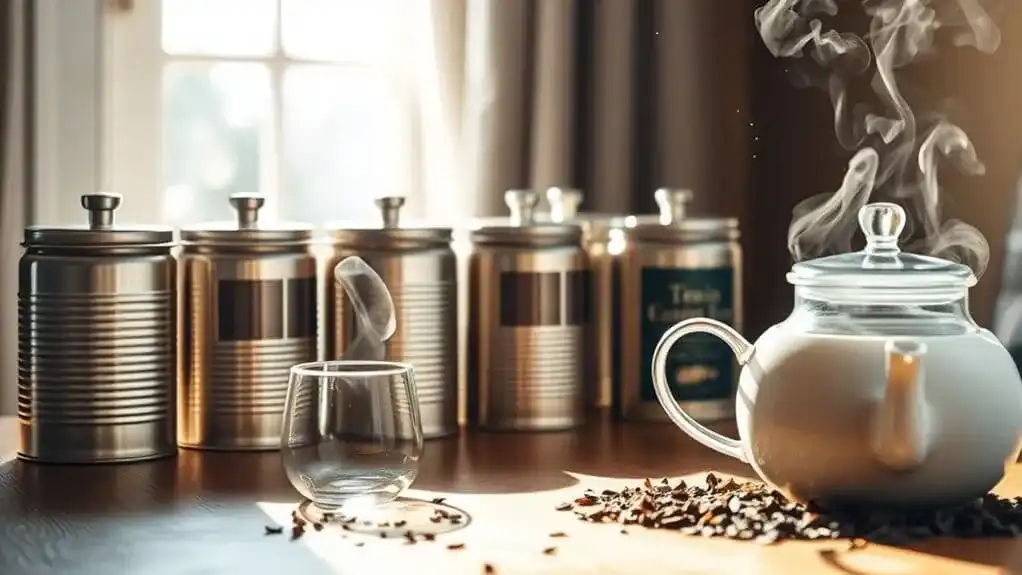
Beyond health claims and certifications, proper brewing and storage methods can make or break your tea experience. Different teas require specific brewing techniques – black tea needs full boiling water and longer steeping, while green and white teas prefer lower temperatures and shorter times. For optimal flavor extraction, steep time varies between 1-10 minutes depending on tea type. For loose-leaf preparation, use 1-2 teaspoons per 8oz of water. Always start with freshly drawn cold water to ensure the best possible flavor.
When it comes to storage methods, protecting tea from environmental factors is essential:
- Keep tea in airtight, opaque containers made of glass, tin, or aluminum
- Store at room temperature (68-77°F) in a dark cabinet away from humidity
- Buy small quantities and consume within months for ideal freshness
Remember to avoid microwaving water for brewing, and always protect tea from light, heat, moisture, strong odors, and excessive air exposure. Using containers with double-sealed lids provides superior protection against moisture and air infiltration.
The Hidden Language of Tea Label Symbols
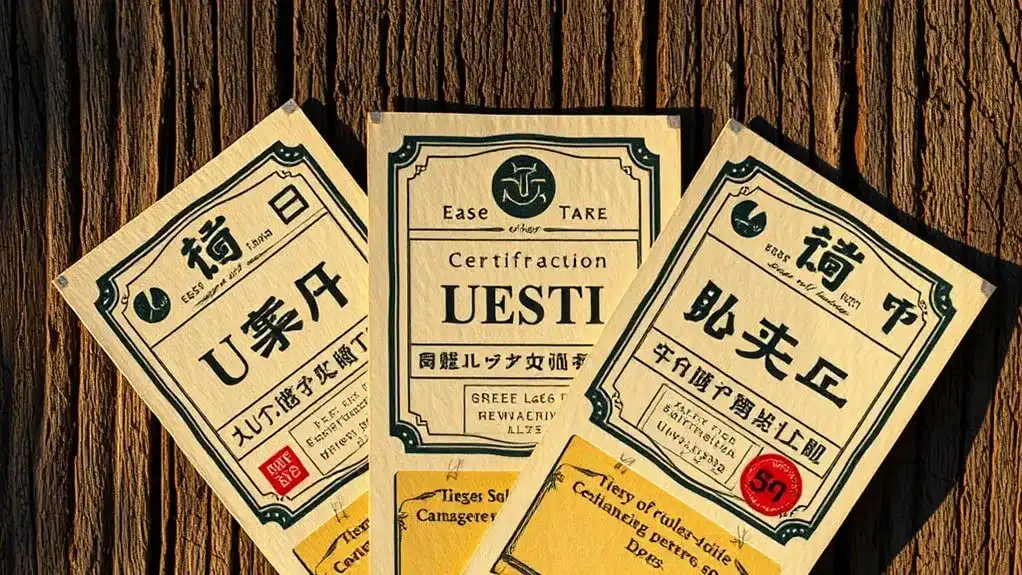
Unlike the mystical practice of reading tea leaves, tea label symbols serve a practical and regulated purpose in today's market. While tea leaf reading relies on subjective symbol interpretation, tea labels follow strict FDA guidelines to provide clear, factual information to consumers.
Label design must incorporate mandatory elements like product information, origin details, and manufacturing processes. These symbols and certifications, such as fair trade logos, aren't open to interpretation – they represent specific standards and requirements. The labels also reflect brand identity while maintaining transparency about the product's contents and quality.
Unlike the personal and intuitive nature of tasseography, where symbols can have multiple meanings, tea label symbols are standardized to guarantee consumer safety and regulatory compliance. They're designed to communicate essential information clearly and consistently across all products.
Conclusion
Reading tea labels is like decoding an ancient map – once you've mastered the symbols and language, a world of flavor opens up. Just as Marco Polo's 13th-century tea discoveries changed Europe forever, today's conscious consumer can navigate through over 1,500 tea varieties with confidence. Armed with this 3-minute guide, they'll breeze through ingredients, origins, and certifications to find their perfect cup every time.
